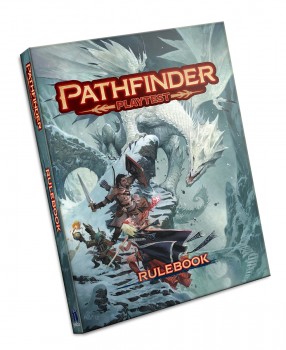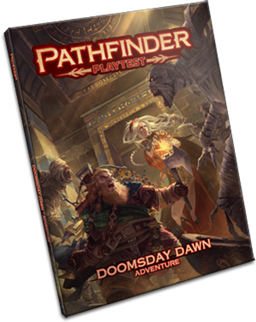Pathfinder Playtest Update
 Since Gen Con 2018, the Pathfinder Playtest has been in full swing, testing the new rule system that will form the basis for Pathfinder Second Edition, slated to release at Gen Con 2019. The game looks to streamline the system, and create a more coherent play experience across the diverse options that players of Pathfinder have available.
Since Gen Con 2018, the Pathfinder Playtest has been in full swing, testing the new rule system that will form the basis for Pathfinder Second Edition, slated to release at Gen Con 2019. The game looks to streamline the system, and create a more coherent play experience across the diverse options that players of Pathfinder have available.
Participating in the Playtest
The major materials – the Pathfinder Playtest Rulebook and the Doomsday Dawn adventure book, as well as supplements like the Playtest Bestiary and pregenerated characters – are all available for free download from Paizo.com, so that anyone can participate in the playtest experience. Feedback is provided through the messageboards on the Paizo forum and also by entering survey data when you’ve run someone through an adventure or scenario.
In addition to the download of the Rulebook, you should also download the Rulebook Update sheet. This is updated regularly – every couple of weeks so far – and includes ongoing modifications to the rules, which are to be incorporated immediately. The biggest change was a pretty comprehensive revamp of the Death & Dying rules, although they’ve since gone in and modified some of the classes a bit, added an additional healing option for the Medicine skill, and made other changes as needed.
The Doomsday Dawn adventure book has a series of 7 adventures that are linked together in a campaign style, set over a period of ten years, but you don’t always play the same characters. The adventures begin at first level and then skip levels as you proceed. The characters you play at first level show up in subsequent adventures, at higher levels, but in between you play with some different characters, with some adventures focusing more on outdoor adventures or healing characters. The goal is that playing through the entire adventure, you’ll have an opportunity to test out lots of different play styles and aspects of the game.
Paizo has been focusing on a different adventure every couple of weeks, and they’re now up to Adventure 4. Once you play the adventures, there are links to online surveys on the Pathfinder Playtest website where you can provide detailed feedback they use to see if the results are matching their expectations or if there are unexpected bugs showing up in the data. Even if you start now you can still report on Adventure 1, and they can use that information to calibrate how the updates to their rules are impacting the low level adventures. In addition, there are a series of Pathfinder Society adventure scenarios, which are allowing for regular feedback on performance at set levels as the rules get updated.
Seven Changes of Note
 Having played a variety of scenarios at this point, here are some of the most noticeable changes in the character creation and game play process.
Having played a variety of scenarios at this point, here are some of the most noticeable changes in the character creation and game play process.
- Proficiency levels: One of the major changes is to apply a proficiency level to everything: untrained, trained, expert, master, or legendary. The proficiency bonus increases as you level up, but is adjusted based on the amount of training, from a -4 modifier (per the latest rules update) at Untrained to a +3 modifier at Legendary. In addition to proficiency levels on Perception, Saving Throws (still just Fortitude, Reflex, and Will), and Skills, you also have proficiency levels assigned to types of armor, weaponry, and magical types. So a wizard is untrained in armor, but trained in some weapons (club, staff, etc.) and some skills, but also in attack rolls with arcane spells, spell rolls, and spell DCs. A fighter, on the other hand, begins play expert in simple and martial weapons and trained in armor and exotic weapons.
- Critical Success and Failure: In addition to rolling natural 1’s and 20’s, critical successes and failures come when you fail or exceed a target DC by 10 or more. This usually results in absolutely no effect or a double effect, depending on the situation. A critical success on an attack roll does double damage while a critical success on a saving throw typically avoids all negative effects. A critical fail on a save means you take double damage. A critical success on trying to use the Break Open action with Athletics means that you can break open an object like a door without actually damaging it.
- Action Economy: Every character gets 3 actions and a reaction every turn. This means that some class abilities – like the Fighter’s ability to use the reaction Attack of Opportunity or the Monk’s Flurry of Blows ability to use one action to make two attacks – become extremely useful within this action economy. The multi-attack penalty which accumulates means that particularly at low levels, even though a player could make three attacks, there generally isn’t much of a benefit to doing so. That third attack is so unlikely to hit that if you can think of something else to do, it’s usually worth while to give it a try.
- Ancestry: Instead of picking an ancestry like Dwarf or Gnome or Human and getting all of those species-based bonuses and abilities up front, characters now gradually gain Ancestry Feats as they level up (levels 1, 5, 9, 13, and 17), essentially unlocking more and more of the potential from their lineage as they grow and develop. So a young elf may have naturally Keen Hearing (an elven heritage feat that can only be taken at 1st level), but at 5th level they gain the Nimble feat and at 9th level gain the Otherworldly Magic feat, granting the ability to cast a cantrip. Also, mixed heritage like half-elf and half-orc are now represented by playing a Human who takes the appropriate Ancestry Feat, which unlocks the ability for that character to gain Ancestry Feats from those other ancestries.
- Backgrounds: Backgrounds are a generally minor part of the character build process. Each Background provides a couple of Ability boosts, training in a Lore skill (a mix of Knowledge and Professional ability), and a skill feat related to the background. The Acrobat background grants the Steady Balance skill feat and training in Circus Lore, as opposed to the Noble background which grants the Courtly Graces skill feat and training in Nobility Lore. A bard with the Entertainer background will be slightly different from one with the Barkeep background, even if both get boosts to Charisma and Dexterity out of the deal.
- Resonance: To provide some limitation on out-of-control magic items, the new system includes a trait called Resonance, which limits the number of magical items that characters can wield at any time. Resonance points are based on a character’s level plus Charisma modifier. Ongoing magical items, like magical weapons and armor, must be attuned in the morning by spending a Resonance point. Other magical items, like potions and wands, are activated through spending a Resonance point. At low levels, this can mean it’s relatively easy to run out of Resonance points, which can be a problem for characters who rely too heavily on magical items. (Alchemists, however, base their Resonance points on Intelligence rather than Charisma.)
- Silver-based Economy: Though this doesn’t overall have much impact, the economy of the world has been scaled back, based more on silver than on gold. Again, this is really just a numeric shift that has little impact on gameplay, but for people who are used to tossing gold pieces around like they’re chump change, it could take some getting used to.
Have you tried out the Pathfinder Playtest? What did you think? What other changes have you found most interesting and dramatic?
Additional Articles